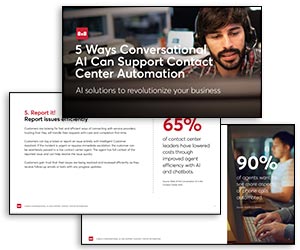Tricia Morris at 8×8 looks at how to navigate the new era of work.
It’s clear that since many employees have had the opportunity to experience remote work, the majority won’t want to go back to a fully office-based role. In a poll of more than 800 LinkedIn users, 77% said that a call for return to office (RTO) would increase resignations.
Remote and hybrid work supports work-life balance, living in a preferred or lower-cost location, and swapping daily commutes for more time with family, exercising, or taking up new hobbies. Recent surveys have found that:
- 42% of employees want to work mostly from home and only sometimes from their usual place of work—a rise of 12% in a year
- 64% of workers would consider quitting if they were asked to return to the office full-time
- Nearly two-thirds (65%) of US-based Gen Z workers said a hybrid workplace is important when considering a potential employer
However, recent data suggests that despite the unprecedented number of people working remotely, the overall rate of worker productivity has stayed the same. The resounding change, however, has been on people’s perception of productivity.
Workers feel more productive, and that’s a plus. Below we look at productivity rates, people’s perception of productivity, and current collaboration considerations.
Productivity Reality
We’ve all heard anecdotes about people working from home and getting far more done than ever before. But not all of the anecdotes match with the current statistics.
According to the Office for National Statistics, UK productivity hasn’t increased in an anomalous way since the shift to primarily remote office work.
While the change was significant (and lots of tech was required to ensure that this change was smooth), there’s only been a 1.9% per hour output increase since 2020. This is roughly what it would have been given 2009-19 estimates.
We shouldn’t necessarily think of this as a negative, though. The seismic shift from the corporate office to home could have made productivity levels plummet.
Instead, thanks to communication technology and quick work from IT departments, the sharp end of the stick was blunted. Without it, productivity would have dropped massively.
Productivity Perception
Still, something about those productivity anecdotes rings true: employees now perceive themselves as being more productive. They feel like they’re getting more work done. But why do people think they’re more productive, and why does that matter?
Now that people can work from anywhere, they appear to be working with fewer distractions. Nearly 70% of people working remotely say they experience fewer distractions, 68% report they have a quieter working environment, and 63% say they have more focused time.
So, with fewer distractions and the ability to concentrate better, remote and hybrid workers feel like they’re more productive.
This matters for three main reasons:
1. People’s Perception of Productivity Increased With a Change in Work Models.
Once these models become the norm, and people settle into this new way of working with optimized long-term technology, this should lead to real and noticeable productivity gains across the board. In short, fewer distractions coupled with new work habits and better tech will bring better results.
2. When People Feel Like They’re Being More Productive, It Has a Positive Impact.
Employees who feel more productive are apt not only to gain more confidence at work, but to do more as a result. Feeling more productive also leads to employee happiness and advocacy—not to mention better relationships and collaboration at work.
Plus, most employees will strive to show increased productivity moving forward, so they can continue to work in a remote or hybrid setting over the long term or permanently.
3. Remote or Hybrid Work Is Here to Stay.
Expectations and demands for these options are on the rise, and multiple studies have shown that employees are less likely to leave a job when they’re given the option to work remotely.
Plus, those workers who perceive themselves as happy and more productive in an all-remote or hybrid environment will be more likely to invite their talented colleagues to join them.
Hybrid Work in Sync
The flipside of this—and there’s always a flipside—are the workers who report themselves to be less productive at home: 55% of those employees have already returned to the corporate office to continue work. It’s therefore beneficial for businesses to support employees with the space and the tools that allow them to work from where they do their best.
Although more and more organizations are supporting work from anywhere, hybrid working models are becoming the most common. In the UK, 42% of employees say they’ll mostly work from home with occasional visits to the office.
But we also know from anecdotal evidence that people are frustrated by calls to return to the office (RTO) when they consider it to be pointless. People don’t want to commute to the office to then sit in on video calls and meetings that they could have done at home.
Enabling Long-Term, Work-From-Anywhere Productivity
If teams and organizations want to ride the success of the shift to working from anywhere, then they need to be intentional about it. To do this, they should embrace better collaboration tools and commit to a purposeful schedule.
A “bottom up” schedule for flexible or hybrid working allows employees to determine when it is best for them to be at home or the office, and when they’ll have the most opportunity for in-person communication and collaboration.
When optimized and unified for hybrid work or work-from-anywhere environments, collaboration tools allow teams to genuinely work together wherever, rather than needing to be in the same room.
Despite unprecedented change, communication technology has allowed us to keep productivity levels in step over the past few years, while also giving us the feeling of being more productive while working remotely.
Moving forward, however, business leaders must be strategic in how they implement and optimize their hybrid and work-from-anywhere models and technology. Those who do will likely see productivity soar.
This blog post has been re-published by kind permission of 8x8 – View the Original Article
For more information about 8x8 - visit the 8x8 Website
Call Centre Helper is not responsible for the content of these guest blog posts. The opinions expressed in this article are those of the author, and do not necessarily reflect those of Call Centre Helper.
Author: 8x8
Published On: 20th Oct 2022 - Last modified: 25th Oct 2022
Read more about - Guest Blogs, 8x8






 8x8 is transforming the future of business communications as a leading Software-as-a-Service provider of voice, video, chat, contact centre, and enterprise-class API solutions, powered by one global cloud communications platform.
8x8 is transforming the future of business communications as a leading Software-as-a-Service provider of voice, video, chat, contact centre, and enterprise-class API solutions, powered by one global cloud communications platform. 





























